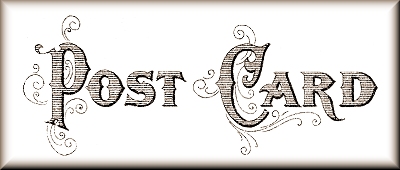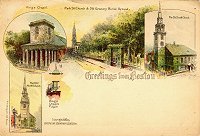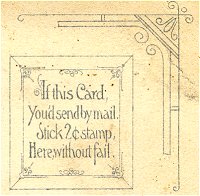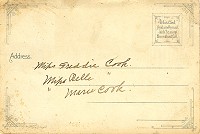

Cards from later periods can also
be dated if they were not postmarked, or there were no cars or people in
the view, by the style. Below are some quick pointers with links to more
detailed information done well by others.

"Copyright 1895 by American Souvenir Co. Boston" |
 |

Two cent stamp required because it was a private card. Cute poem in stamp box. |
The use of the term "POST CARD"
was granted by the government to private printers on December 24, 1901.
Writing was still not permitted on the address side.
Postcards with a divided back were
permitted March 1, 1907. The address to be written on the right side and
the left side was for writing messages. These cards usually had no border.
Most of our postcards were printed
in the USA during this period. To save ink, a border was left around the
view thus we call them "White Border" cards. There are earlier white borders.
New printing processes allowed printing
on postcards with high rag content that caused a "linen-like" finish. Although
first printed in the early 1930’s, these early cards look like white border
cards and only close inspection will detect a texture. The color of the
later card tended to be very artificial and gaudy.
In the mid 1940’s “Photochrome”
cards began to be produced in great numbers, although the first ones appear
earlier. These are the cards that look most like real color photographs
and the process, with improvements and card size changes, continues today.
Real photo postcards are photographs, often with a hand-written caption on the negative, printed on special postcard stock. Real photos also date from early in the century, but are still being made today. Cards that are merely based on photographs but printed through means such as lithography or other printing technique are not real photo (RP) cards.
How does one recognize Real Photo (RP) cards?
The easiest way to recognize Real Photo cards is to look at the card under slight magnification. RP's do not have the dot pattern seen on modern cards. Most printed cards will have this dot pattern, much like a photograph printed in a magazine or newspaper. A "real photo" postcard is solid, no dots. Additionally, RPs can be identified, and dated, by the photographic paper used. This is often indicated on the back. Also, the captions were often "scratched" or marked on the negative in some other way that leaves the text white in color. Not all black-and-white cards are Real Photos, and not all Real Photos are black-and-white. The best way to tell the difference is to look at the postcard with a magnifying glass.
| 1872 to 1916 | .01 |
| 1917 to 1918 | .02 |
| 1919 to 1924 | .01 |
| 1925 to 1927 | .02 |
| 1928 to 1951 | .01 |
| January 1, 1952 | .02 |
| August 1, 1958 | .03 |
| January 7, 1963 | .04 |
| January 7, 1968 | .05 |
| May 16, 1971 | .06 |
| March 2, 1974 | .08 |
| September 14, 1975 | .07 |
| December 31, 1975 | .09 |
| May 29, 1978 | .10 |
| March 22, 1981 | .12 |
| November 1, 1981 | .13 |
| February 17, 1985 | .14 |
| April 3, 1988 | .15 |
| February 3, 1991 | .19 |